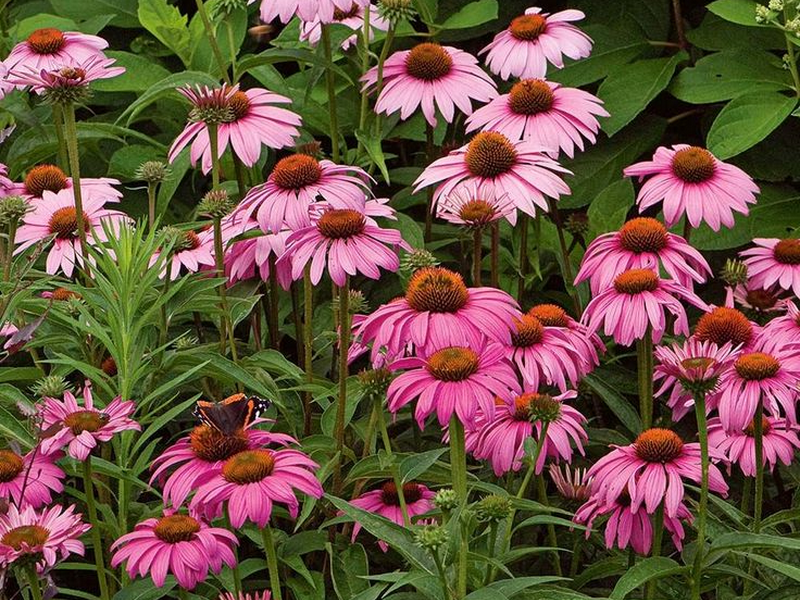Purple Coneflower
Echinacea purpurea
Click here to download a PDF of this plant information page (for printing).

Sun Exposure: Sun, Part Sun
Season of Interest: Summer, Fall
Bloom Time: June - September
Bloom Color: Lavender to Purple
Height: 36 to 42 in.
Spread: 24 in.
Spacing: 28 in.
Water Needs: Drought tolerant
Maintenance: Deadhead
Soil Type: Clay, Loam, Sandy
Soil pH: Neutral
Soil Drainage: Well drained
Pests: Deer and Rabbit resistant
Diseases: Leaf spot, Aster yellows
Wildlife: Bees, Butterflies, Birds

Description:
Purple coneflowers are quintessential field and meadow plants. Native to eastern North America, they are hardy, drought-tolerant, and long-blooming. It's hard to find a garden without at least one. Started from seeds in early spring (after the final frost), coneflowers will germinate in about three to four weeks and produce leaves in three months but can take up to two years to actually produce blooms. This plant has a fibrous root system, rather than the long taproot and woody crown found in other native species, making it more adaptable to garden conditions, and more forgiving of dividing and transplanting.
br>The daisy-like booms are actually made up of several small flowers, with petals that are sterile to lure insects toward the many fertile flowers in the central disk or cone. These flowers are rich in nectar and very popular with both bees and butterflies. Hummingbirds also enjoy coneflowers, and birds like finches eat (and spread) the seeds. For more information see:
plants.ces.ncsu.edu/plants/echinacea-purpurea
Care and Growing Tips:
Purple coneflowers grow well just about anywhere in North America and once established, coneflowers are rugged and hardy. To get the most blooms (and the sturdiest plants), plant your purple coneflowers in a spot that gets at least six to eight hours of full sunlight each day. The plants will tolerate partial shade, but may eventually flop over, and the blooms won't be as prolific.
Coneflowers grow best in a garden that boasts a neutral soil pH. They can thrive in a variety of soil types, including sandy, rocky, and clay soils. However, they do not like wet or mucky soil. For best results, add a bit of compost to your mixture when planting to give your coneflowers successful a good start. Water them daily just after planting, As a native plant, purple coneflower thrives in hot, dry climates but can handle a range of temperature and humidity fluctuations. Although coneflowers thrive best in a soil high in organic matter, too much supplemental fertilizer can cause them to become leggy. Adding compost each spring usually gives them the nutrition they need for healthy foliage and blooms. Pruning purple coneflower is helpful, but not necessary. You can leave the plants standing throughout the winter months to feed the birds. That being said, deadheading is the primary maintenance for coneflowers and will keep them in bloom all summer.